
Last updated: Jan. 29th 2011
When it comes to a comparison of two online poker rooms there is one match-up in particular which already got it's fair share of attention: PokerStars vs Full Tilt Poker.
And this is not surprising considering the fact that PokerStars and Full Tilt Poker are the two biggest online poker rooms in the world with on average 32.000 and 18.000 active cash game players respectively. For US-citizens PokerStars and Full Tilt Poker are the only options with high traffic throughout the day as the numbers three and four are rooms from the Cereus and Cake Network with on average only 1.900 and 900 active cash game players.
So why another 'PokerStars vs Full Tilt Poker' match-up if there are already so many articles floating around the internet covering the same online poker room comparison? Well, most of these comparisons of PokerStars and Full Tilt are inconclusive, outdated, incomplete or a combination of these three and therefore leave the answer to the question: "Which one is better: PokerStars or Full Tilt?" kind of in the middle. Especially when it comes to comparing rake structures and the PokerStars VIP-program to Full Tilt's rakeback and loyalty program most comparisons are outdated and incomplete. And this article is meant to be quite the opposite.
Contents of this PokerStars vs Full Tilt Poker match-up:
Both Full Tilt Poker and PokerStars offer a very wide variety of poker games, including draw games such as 5-card draw and 2-7 triple and single draw. PokerStars also offers badugi games which Full Tilt does not. Full Tilt Poker on the other hand offers a wider variety of mixed games (although considering the traffic in these games the added value of them is questionable). Shorthanded as well as full ring hold'em players have enough games to choose from at both PokerStars and Full Tilt Poker.
Full Tilt Poker launched a completely new game in the beginning of 2010 called 'Rush Poker'. It's not really a new poker variation, but it certainly is a completely new and innovative cash game format. Unlike standard online cash games, in Rush Poker games you don't have to wait for your turn when you fold a hand. The 'quick fold' option directly takes you to another table where a new hand will be dealt instantly. The result is a very fast game play in which you make decisions in a 'vacuum', that is, without any information about your opponents.
At Full Tilt Poker there's a higher ceiling to the stakes offered: $500/$1000 at no-limit and $3000/$6000 at fixed limit games compared to $200/$400 and $1000/$2000 respectively at PokerStars.
At the bottom of the chain PokerStars offers $0.02/$0.04 fixed limit games where those of Full Tilt Poker start at $0.05/$0.10. The blind levels offered at nano and micro stakes no-limit cash games are equal.
Nice feature at PokerStars' deep tables (with a buy-in of 100-250 bb) and at some tables at Full Tilt Poker is the availability of cash games with antes.
The maximum buy-in at 2nl and 5nl is different for both poker rooms: 250 big blinds at PokerStars vs 100 big blinds at Full Tilt Poker (with the exception of some 'deep' tables where the maximum buy-in is 200 big blinds). The minimum buy-in at PokerStars is $0.80 at 2nl and $2 at 5nl vs $0.70 and $1.75 at Full Tilt Poker respectively.
As mentioned above Full Tilt Poker offers deep tables where the minimum buy-in is 50 BB and the maximum buy-in is 200 bb. From 10nl and up, PokerStars offers tables with a buy-in of either 20-50 bb, 40-100 bb or 100-250 bb.
Variations - At PokerStars you can play Double or Nothing tournaments (DON's); sit and go's in which the top 50% win double their buy-in (not taking rake into account). Full Tilt Poker on the other hand offers Matrix tournaments which you won't find at PokerStars.
Field size - The field sizes of the multi-table tournaments at PokerStars are generally larger then those at Full Tilt Poker. This means that the variance at PokerStars can be higher.
Stakes - At stakes below $1 PokerStars offers tournaments for which no rake (entry fee) is charged, while Full Tilt Poker only offers some satellites at these levels. Other than that the range of stakes is very similar at both sites.
Volume - Both PokerStars and FullTilt Poker offer a high volume of tournaments. Traffic at PokerStars is higher which causes multi-table Sit and Go's to fill up more quickly and first prizes in multi-table tournaments to be larger.
The lobbies of both PokerStars and Full Tilt Poker are equally as functional. Nice features that set Full Tilt Poker apart from PokerStars are the option to customize your lobby with certain widgets, to choose from different views and to see color codes you assigned to your opponents next to their names when selecting a table. Some screenshots (click to download):


Both poker rooms have all the features you could wish for as a multi-tabler or even as a mass multi-tabler. Both rooms are compatible with PokerTracker and HoldemManager; for both PokerStars and Full Tilt there are a ton of AHK-scripts available and auto reloading is no problem at all. The difference between PokerStars and Full Tilt when it comes to multi-tabling is the maximum number of tables: 24 at PokerStars vs 16 at Full Tilt (after asking support to up your limit). Furthermore PokerStars runs more smoothly than Full Tilt Poker when multi-tabling and using a HUD: Full Tilt can sometimes become incredibly laggy when multi-tabling, while at PokerStars these moments are exceptionally rare (even when 24-tabling). PokerStars also has a very nice feature where you can choose to sit out or stand up from all tables at once.
The instant hand history feature of Full Tilt vs PokerStars' is very visually pleasing so to speak: a nice replay option with card pictures vs a plain hand history in text format from PokerStars. Full Tilt Poker has nice avatars, while at PokerStars you're glad sometimes that you can disable the custom pictures people use as an avatar. Furthermore, the poker pros are more present at Full Tilt Poker because the tables where they play at are displayed in red in the lobby. And who doesn't like to watch the fireworks of pots that exceed the value of your own house getting tossed around or to sit at a micro stakes table having position on a WOSP-bracelet winner?
So, while there certainly are some differences in the games offered and the software between PokerStars and Full Tilt Poker, these differences are mostly minor and do not heavily favor one room over the other in an objective way. When it comes to rake and rakeback at PokerStars vs Full Tilt, there are some very distinct differences however. PokerStars' rake structure is very standard for the online poker industry, while Full Tilt has been known for taking high rake percentages especially at the lower stakes. It wasn't until recently that PokerStars upped their first deposit bonus from a measly $50 to match the nice $600 one of Full Tilt. But mostly PokerStars has been the room without rakeback while at Fill Tilt Poker new players can get 27% rakeback when signing up through a website that can offer it to them. Let's see how all this adds up.
Both PokerStars' rake structure and Full Tilt Poker's rake structure are already presented in another article about rake on FirstTimePokerPlayer.com. The biggest differences in rake structure at PokerStars vs Full Tilt Poker are the following:
Micro stakes fixed limit games
At micro stakes fixed limit games (up to $0.10/$0.20) PokerStars charges a lower maximum amount of rake. The pot size increments from which rake is taken are equal at both PokerStars and Full Tilt. At Full Tilt the maximum amount of rake will almost never be reached in these games in contrast to PokerStars. It is difficult to say how this affects the average amount of rake taken in these games when comparing PokerStars vs Full Tilt Poker other than that it might be lower over at PokerStars.
Micro stakes no limit games
At micro stakes no limit games the maximum rake at PokerStars and Full Tilt poker is the same. However, Full Tilt Poker takes rake from smaller pot size increments and also rakes a higher amount per dollar at 2nl, 5nl and 10nl when compared to PokerStars ($0.01 for every $0.15 in the pot vs $0.01 for every $0.20 in the pot, respectively). This is presented in the following graph:
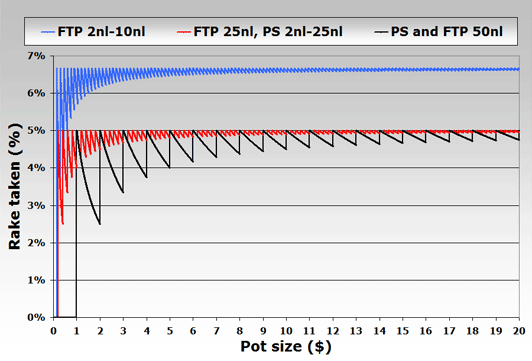
This results in a higher average amount of rake taken at the lower stakes at Full Tilt Poker:
| Room | 2nl | 5nl | 10nl | 25nl |
|---|---|---|---|---|
| PokerStars | 4.1% | 4.6% | 4.8% | 4.7% |
| Full Tilt Poker | 5.8% | 6.3% | 6.5% | 4.9% |
| FTP + 27% RB | 4.2% | 4.6% | 4.8% | 3.6% |
Note: the average rake percentages in the table above are calculated from the data used for rake and rakeback at the micro stakes. Calculations made are based on 27% dealt rakeback for Full Tilt Poker. Rakeback at Full Tilt Poker is now calculated according to the 'contributed' method, however, which could mean that the numbers for FTP with 27% rakeback might be different for you. Generally the 'contributed' method is less favourable than the 'dealt' method for tight players, and therefore the avarage amount of rake at Full Tilt Poker with 27% rakeback could be slightly higher than presented above.
"Why is the average rake taken at PokerStars vs Full Tilt Poker so important?", you might be wondering. Well, you can't get back what you don't pay. And although Full Tilt Poker offers 27% rakeback, they also take more rake in the first place. And as you can see in table 1, rakeback at Full Tilt Poker does not even compensate for the higher percentage of rake taken compared to PokerStars at 2nl, 5nl and 10nl. Only at 25nl does Full Tilt seem to be the better deal, that is, without considering the benefits of PokerStars VIP club (discussed later in this article).
Heads-up and high stakes games
The same amount of rake is taken by both Full Tilt Poker and PokerStars in heads-up games. Less rake is taken at high stakes games by Full Tilt Poker vs PokerStars.
PokerStars and Full Tilt Poker both offer a 100% first deposit bonus up to $600. To clear these bonuses you have to earn 17 VPP's for every dollar at PokerStars vs 25 player points per bonus dollar at Full Tilt. Seeing that 5.5 PokerStars VPP's are earned for every $1 in tournament entry fees in 2011 vs 10 FTP's at Full Tilt, these bonuses result in approximately 32% and 40% of your paid rake back respectively. At PokerStars you have more time before the bonus expires and you can make up to 3 qualifying deposits to receive the full bonus. Furthermore, if you take into account that the bonus amount cleared at Full Tilt is deducted from your MGR (your Monthly Gross Rake, and therefore your rakeback) then the actual benefit in terms of rakeback is around 29%. In PokerStars' full ring, 2nl, 5nl and 10 nl games you receive more FTPs per dollar raked and the equivalent bonus rakeback percentage will be up to 26% higher. Yet another table:
| PokerStars | Full Tilt Poker | |
|---|---|---|
| Bonus | 100% up to $600 | 100% up to $600 |
| Requirements | 17 VPP's for every $1 | 25 FTP's for every $1 |
| Increments | $10 | 10% or $20 (whichever is lower) |
| Valid for | 180 days | 120 days |
| Rakeback % | T/SH: 32%; FR: 35%; 2nl: 59%; 5nl: 50%; 10nl: 41% | Around 29% (incl. MGR deduction) |
| Bonus code | STARS600 | None needed |
| Other | 3 qualifying deposits possible | Deducted from MGR |
Both the loyalty programs of PokerStars and Full Tilt Poker are very (overly?) complex and are therefore hard to compare. Because of that, the total rakeback equivalents for both these programs presented in this article article are not exact but a mere estimation, which might be disappointing for some of you. Follow the links for the exact details of the PokerStars VIP club and the Full Tilt Poker iron man challenge.
Why are PokerStars' and Full Tilt's rakeback program so hard to compare?
Well, the eventual benefit you get from both these programs in terms of rakeback depends on a lot of variables. In general the more you play and therefore the more rake you generate, the better your return will be. Part of the value of these programs is given to you in the form of freeroll entries. Obviously you have to be able/willing to play those to get any value out of them and even then it's impossible to say what the exact value will be for you in particular. The value of these rakeback programs will be different for full ring, shorthanded and tournament players. And both VIP-programs require another 'commitment' to really benefit from them. While the iron man challenge requires you to play as consistently as possible (250 FTPs for 25 days or 500 FTPs for 20 days per month for iron man status), the PokerStars VIP-program allows you to take some days off and compensate them at another moment that month. Furthermore, at PokerStars it will take quite some time before you have accumulated enough VPP's and FPP's before you can start 'harvesting' your rakeback, while at Full Tilt there will be a steady weekly rakeback stream with some longer term iron man benefits. And it is very hard to say what exactly the added value will be of having those funds at your disposal more quickly.
With that being said, let's just take a crack at it nonetheless.
On the page about PokerStars rakeback the equivalent rakeback percentages of the different VIP levels, stellar bonuses and milestone bonuses have been calculated. Figures 1 to 3 on that page show you the rakeback percentages when earning a different amount of VPPs per day. In summary, the result of PokerStars' VIP program is a top heavy reward structure in which poker players at higher stakes and especially very high volume players are rewarded the most.
The page about Full Tilt Poker rakeback (Figures 2 and 3) on the other hand, shows a total rakeback structure through rakeback, points and the Iron Man and Black Card promotions that rewards low volume/low stakes players relatively more than the big rakers. Especially the Iron Man promotion results in high total rakeback percentages of more than 65% when earning only 50 base FTPs/day in the first year already.
Because a different amount of VPPs and base FTPs are earned per dollar raked at PokerStars vs Full Tilt, I recalculated these points into 'dealt rakeback' to be able to show both the rakeback at PokerStars and Full Tilt Poker in one figure. In addition, for a comparison of PokerStars vs Full Tilt rakeback at 2nl, 5nl and 10nl the data are recalculated to take into account the different amounts of rake taken at both poker rooms. For all the following figures it is assumed that you play the same amount of hands every day of the year. For the other assumptions made in calculating rakeback percentages I would like to advise you to take a look at the rakeback pages of PokerStars and Full Tilt mentioned.
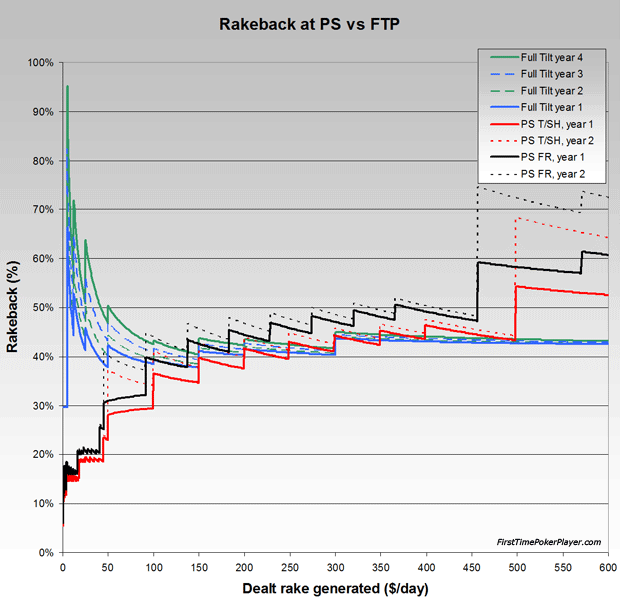
What does this figure mean?
When generating up to $100 dollars in rake per day at 25nl full ring games and higher (= 1000 FTPs or 600 VPPs/day), the amount of rakeback at Full Tilt Poker exceeds the amount of rakeback earned at PokerStars. The less rake you generate, the bigger the difference becomes (even exceeding a whopping 50% in rakeback). Clearly, playing at Full Tilt Poker will be cheaper than at PokerStars when you rake somewhere in this range. Roughly this would be the case for all low to high volume 25nl and 50nl players and for low to medium volume 100nl and higher stakes players. For shorthanded cash and tournament players the thresshold will be approximately $200 in rake generated per day (2000 FTPs or 1100 VPPs/day).
At high playing volumes between $100 and $450 (FR) or between $200 and $500 (tourney and SH) in rake generated per day the difference in rakeback at Full Tiilt Poker and PokerStars is small: up to 8% mostly in favour of PokerStars.
At extremely high playing volumes above $450-$500 in rake generated per day PokerStars comes out as a clear winner. Their Supernova Elite VIP level results in at least an extra 10% rakeback (first year, tournaments and shorthanded cash) up to 30% (second year playing full ring) when compared to Full Tilt Poker.
It is generally thought that if you can make it to SuperNova status at PokerStars that your return will eventually be better than with the 27% rakeback, the Iron Man Challenge, Black Card and the Full Tilt Points combined at Full Tilt Poker. Figure 2 shows that reaching Supernova alone is not enough: you would have to make it to at least the 200,000 VPP milestone bonus at PokerStars when playing full ring or the 300,000 VPP milestone when playing tournaments and shorthanded cash games.
Okay, so what about rakeback at the micro stakes then? Well, let's take a look at Figures 3, 4 and 5:
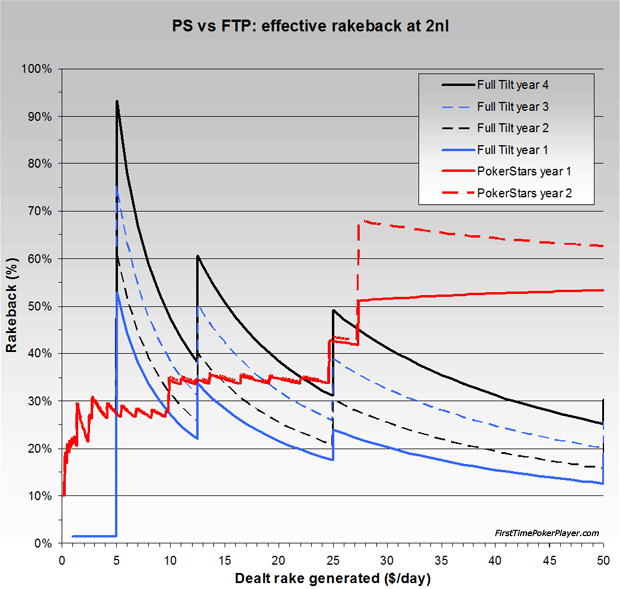
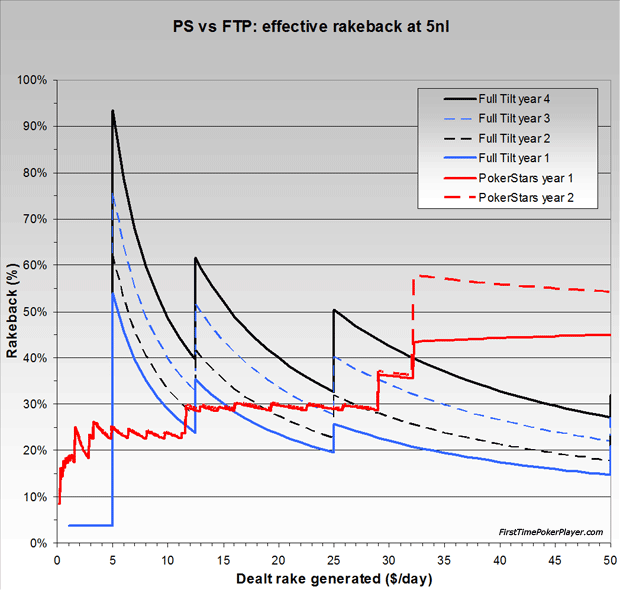
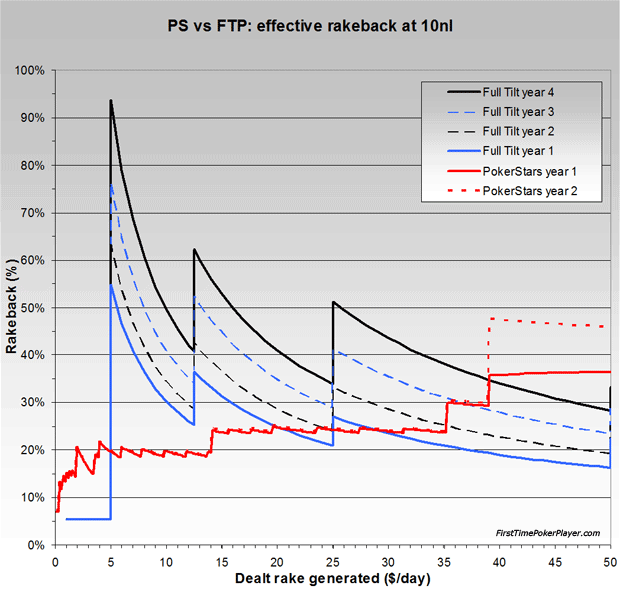
What do these figures mean?
At 2nl when raking up to $5 a day, you would play cheapest at PokerStars. The first year your rakeback will generally be highest at PokerStars when compared to Full Tilt, but as you maintain you Iron Man status at FTP and start earning more and more medals per month your rakeback will become highest at Full Tilt Poker when raking between $5 and $25 per day (50-250 FTPs or VPPs/day). When raking more than $25/day, PokerStars' VIP program combined with the lower amount of rake taken are clearly more valuable than 27% rakeback, points and medals combined at Full Tilt Poker, with a difference in effective rakeback of up to 45% in the second year.
At 5nl and 10nl the smaller difference in the average rake percentage taken from the pot between PokerStars and Full Tilt Poker causes Full Tilt Poker to be more and more attractive to play at. Only at very low playing volumes (raking up to $5/day), very high playing volumes (raking more than $32 and $39 per day at 5nl and 10nl respectively) or when you are unable to maintain your Iron Man status PokerStars is the cheapest room to play at.
Note: everybody signing up at PokerStars will automatically benefit from their VIP-program, whereas you need to sign-up at Full Tilt Poker using a rakeback link to benefit from the 27% rakeback.
Support of Full Tilt vs PokerStars is quite bad. Full Tilt's support team can only be contacted by e-mail and it isn't uncommon for them to take a couple of days to respond. This is in contrast to PokerStars' support team.
PokerStars will be the better choice:
On the other hand, Full Tilt Poker will be the better choice:
Good luck with choosing the best room for you and don't forget that you can always try both PokerStars and Full Tilt poker out yourself to see which room suits you the most. Don't play at one room if it happens to give you more of your paid rake back but when you actually dislike playing there for whatever reason.